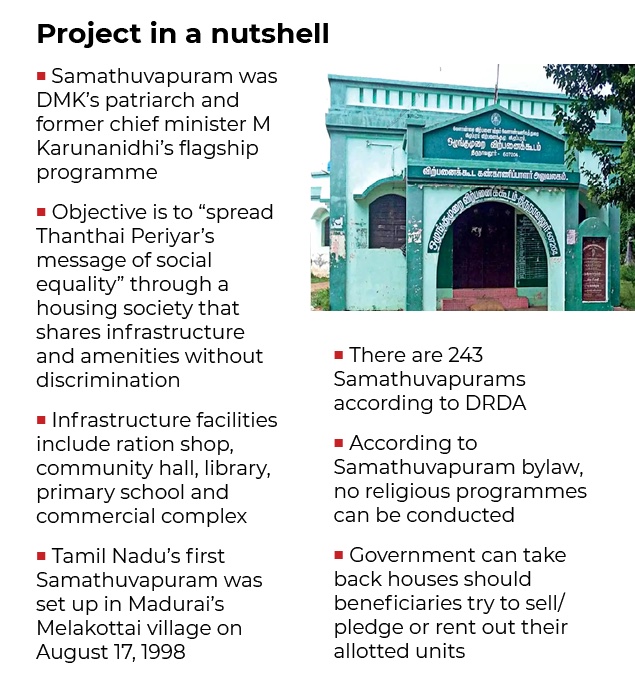Samathuvapuram
This is a collection of articles archived for the excellence of their content. Additional information may please be sent as messages to the Facebook community, Indpaedia.com. All information used will be gratefully acknowledged in your name.
This is a collection of articles archived for the excellence of their content. |
A stillborn scheme
Shanmughasundaram J, Nov 8, 2021: The Times of India

From: Shanmughasundaram J, Nov 8, 2021: The Times of India

From: Shanmughasundaram J, Nov 8, 2021: The Times of India
Fifty-one-year old M Venkatesan has been living in a Periyar Ninaivu Samathuvapuram in Kallakurichi’s Thirunavalur for almost two decades. But over the years, he hasn’t experienced any sense of equality or community, which former chief minister M Karunanidhi had envisioned.
Started in 1998, the objective of the scheme was to “promote social justice and spread Thanthai Periyar’s message of social equality” of an egalitarian society that lives with unity and shares infrastructure and amenities without discrimination. Under the scheme, allotments were made to 40% of people from scheduled castes, 25% each from the most backward classes and backward classes, and 10% to other minorities.
An informal survey of any of the more than 200 Samathuvapurams in the state shows diversity is absent. Now it’s just dilapidated houses, closed community spaces and residents who are poor and forced to live there.
“Only the place is called Samathuvapuram. It is treated like any other government housing scheme with no effort to ensure that people of all communities live together and share facilities on the same campus,” says Venkatesan, who has seen many rent or sell the houses allotted to them and return to their native villages. “Those who continue to live here are mostly the poor and dalits. Most non-dalits who benefited under the scheme returned to their villages to live with their community people,” he says.
The ambitious, almost utopian, idea of a casteless society, where families from different communities and religions live on a campus, needs more than just allotment of houses. Lack of efforts from the government to ensure harmony through common development programmes and maintenance of the structures have meant that the Samathuvapurams have not been able to live up to its name.
“The government should encourage the families to enrol their children in the primary school inside the campus, help in the upkeep of the library and community hall and have programmes on social justice,” says Venkatesan, who says the primary school at his Samathuvapuram has low enrolment with hardly any non-dalit students, who are sent to nearby schools.
Economic disparity of the residents is another obstacle to the idea of equality. Many houses in the Samathuvapurams are in the name of the dalit beneficiaries, but they are inhabited by non-dalits. Shops too are owned by non-dalits, because dalits are too poor to set up shops.
T Chellakannu, president of the Tamil Nadu Untouchability Eradication Front, agrees that the Samathuvapurams have a long way to go to achieve their purpose. “If you visit Samathuvapurams you will find houses of dalits are at the fag end of the colony. Many of them do not have water supply because they cannot pay the deposit of Rs 1,000 for the connection,’’ he says.
Many poor beneficiaries have also mortgaged the houses allotted to them under the scheme. “Many mortgaged their houses to money lenders and have subsequently lost them,” says one of the beneficiaries of Poigai village in Vellore on condition of anonymity.
“Nearly 50% of the beneficiaries of the scheme in Vellore, Ranipet and Tirupattur districts have illegally mortgaged their houses and returned to their villages,” said a source in the DRDA department. The lack of upkeep makes the situation worse. At Vadachittur near Kinathukadavu in Coimbatore district cracked walls, peeled off plaster exposing rusted steel rods are common. “Several houses are severely damaged. In some houses, the toilets have given way,’’ says M Perumal, a resident of the 20-year-old Vadachittur Samathuvapuram.
S Muthuswamy, another beneficiary, blames the disinterest of the AIADMK government for 10 years for the sorry state of affairs. “Without state aid, the programme failed,” says Muthuswamy, a priest at the Bhakthajaneswarar temple — under the Hindu Religious & Charitable Endowments Department —in Thirunavalur, who returned to his village due to lack of basic amenities. His elderly parents, however, stay at the house in a Samathuvapuram.
Chellakannu says the idea of Samathuvapuram needs sustained state backing. “The government should give dalits, loans and mainly access to education because all these Samathuvapurams are situated far from high schools,” he says.
After being left in oblivion for a decade, the newly-elected DMK government has turned its attention towards Samathuvapurams and is planning to address the civic woes. Principal secretary K Gopal told TOI the government has been taking stock of the condition of the houses in Samathuvapurams. “We are also discussing the modalities with regard to the new Samathuvapurams while looking for suitable places,” said the officer. The government would also look into the issues related to ownership of the houses while taking up the repair work.
However, activists feel the government should address socio-economic issues of the residents as well to ensure the beneficiaries live there. The state should adopt a holistic approach and create community activities such as self-help groups for women from different communities.